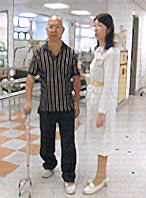Non-medical Treatment
Non-medical treatments of dementia are just as important as medical treatments.
The effect of non-medical treatment, including cognitive training, reality orientation, confirmation therapy, multi-sensory stimulation and other psychological and behavioural treatments, has been proven in academic literatures. These treatments can improve the emotional and behavioural problems of patients, slow down the degradation of cognitive abilities as well as enhance the quality of life.

Non-medical treatment and diverse activities provide dementia patients with suitable training and meaningful activities to keep stimulating the brain and slow down deterioration. Through carefully planned activities, patients can enjoy thorough care for their physical and emotional conditions as well as their social life so as to enhance their quality of life.
Physiotherapy
(1) Early to middle stage
1. Maintain physical mobility and the ability to walk
Early and middle stage dementia patients can still walk freely. Appropriate exercises can help them maintain physical strength and the extent of limb movement, increase their muscle volume and enhance hand-foot coordination for a higher quality of life. Given their deteriorating memory, patients can formulate exercise timetable with their families as a reminder for regular exercise.
 Bend forwards
Bend forwards
 Bend backwards
Bend backwards
 Bend left and right
Bend left and right
 Turn left and right
Turn left and right
Upward arm lift
(Use an umbrella or a water bottle)
Elbow flexion and extension
Closed fist and open hand
 Half squat
Half squat
 March on the spot
March on the spot
 Outward leg raise
Outward leg raise
 Knee joint extension
Knee joint extension
Standing heel and toe raises
2. Use of walker
Middle stage dementia patients will slowly experience decline in their walking ability. After the evaluation of physiotherapist, patients can use suitable walkers to assist walking, improve their ability to walk and reduce the risk of falling.
 Walking stick
Walking stick
 Four-legged walking stick
Four-legged walking stick
 Walker
Walker
 Wheeled walker
Wheeled walker
(2) Late stage
Late stage dementia patients will lose their mobility completely. Caregivers should learn lifting techqiues properly as well as joint stretching to help prevent the onset of joint stiffness and enhance mobility. Family and caregivers should contact physiotherapists for more details.
1. Caregiver training
Lifting by one person
Lifting by two people
Occupational Therapy
The roles of occupational therapists at memory clinics is to help patients and caregivers reduce the problems brought by memory loss and alleviate the burden of caregiver so as to make patients able to remain independent in everyday life and their lives more delightful.
1. Therapists conduct professional cognitive assessment for patients.
2. Instruct caregivers on the right communication skills and provide suggestions for the everyday routine arrangement.
3. Provide suggestions for improvement in living environment to reduce the dysfunction of patients and promote home safety.
4. Instruct caregivers in assisting patients in suitable memory training and reminiscence activities.
Memory training
Photo review
More relevant information (Chinese Version Only)
Source:律敦治及鄧肇堅醫院 - 認知障礙症照顧者手冊